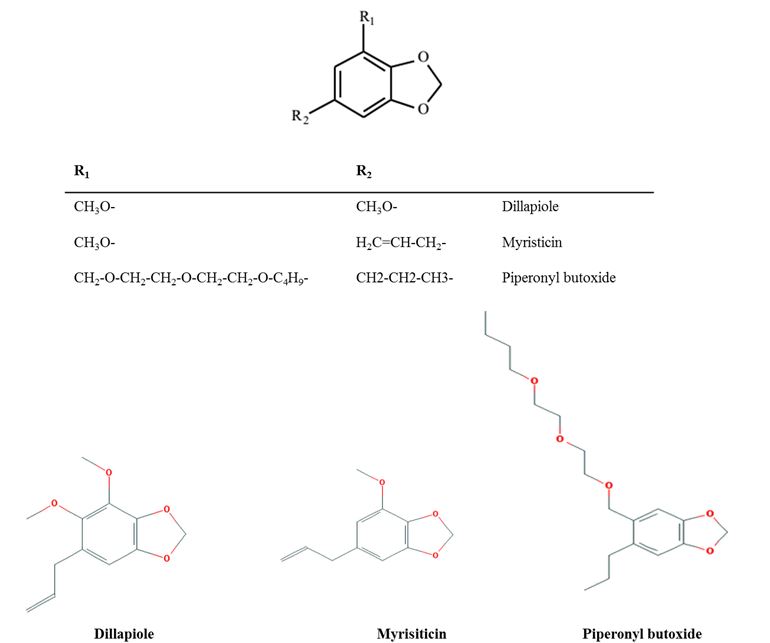|
β-caryophyllene
|
17.4 |
Panama City/Panama |
Vila et al. (2005)Vila R, Tomi F, Mundina M, Santana AI, Solis PN, Arce JBL, et al. Unusual composition of the essential oils from the leaves of Piper aduncum.Flav Frag J 2005; 20(1): 67-69. http://dx.doi.org/10.1002/ffj.1369.
http://dx.doi.org/10.1002/ffj.1369...
|
|
Dillapiole
|
86.9 |
Amazonas/Brazil |
Almeida et al. (2009)Almeida RRP, Souto RNP, Bastos CN, Silva MHL, Maia JGS. Chemical variation in Piper aduncum and biological properties of its dillapiole-rich essential oil. Chem Biodivers 2009; 6(9): 1427-1434. PMid:19774604. http://dx.doi.org/10.1002/cbdv.200800212.
http://dx.doi.org/10.1002/cbdv.200800212...
|
| 45.9 |
Morona/Ecuador |
Guerrini et al. (2009)Guerrini A, Sacchetti G, Rossi D, Paganetto G, Muzzoli M, Andreotti E, et al. Bioactivities of Piper aduncum L. and Piper obliquum Ruiz & Pavon (Piperaceae) essential oils from Eastern Ecuador. Environ Toxicol Pharmacol 2009; 27(1): 39-48. PMid:21783920. http://dx.doi.org/10.1016/j.etap.2008.08.002.
http://dx.doi.org/10.1016/j.etap.2008.08...
|
| 43.3 |
Morobe/Papua New Guine |
Rali et al. (2007)Rali T, Wossa SW, Leach DN, Waterman PG. Volatile chemical constituents of Piper aduncum L. and . Piper gibbilimbum C. DC (Piperaceae) from Papua New GuineaMolecules 2007; 12(3): 389-394. PMid:17851397. http://dx.doi.org/10.3390/12030389.
http://dx.doi.org/10.3390/12030389...
|
| 82.2 |
Pinar do Río/Cuba |
Pino et al. (2004)Pino JA, Marbot RA, Bello A, Urquiola A. Essential oils of (L.) Miq. and L. from Cuba. Piper peltataPiper aduncumJ Essent Oil Res 2004; 16(2): 124-126. http://dx.doi.org/10.1080/10412905.2004.9698670.
http://dx.doi.org/10.1080/10412905.2004....
|
| 31.5 |
Amapa/Brazil |
Maia et al. (1998)Maia JGS, Zohhbi MGB, Andrade EHA, Santos AS, Silva MHL, Luz AIR, et al. Constituents of the essential oil of L. growing wild in the Amazon region. Piper aduncumFlavour Fragrance J 1998; 13(4): 269-272. http://dx.doi.org/10.1002/(SICI)1099-1026(1998070)13:4<269::AID-FFJ744>3.0.CO;2-A.
http://dx.doi.org/10.1002/(SICI)1099-102...
|
| 50.8-86.9 |
Para/Brazil |
| 91.1-97.3 |
Amazonas/Brazil |
| 88.1 |
Acre/Brazil |
| 64.5 |
Kuala Lumpur/Malaysia |
Jantan et al. (1994)Jantan BI, Ahmad AR, Ahmad AS, Ali NA. A comparative study of the essential oils of five species from Peninsular Malaysia. PiperFlavour Fragrance J 1994; 9(6): 339-342. http://dx.doi.org/10.1002/ffj.2730090611.
http://dx.doi.org/10.1002/ffj.2730090611...
|
| 90.0 |
Panama |
Gupta et al. (1983)Gupta MP, Arias TD, Smith RM. The composition of the essential oil of Piper aduncum L. from Panama. Rev Latinoamer Quim 1983; 14(1): 35-36.
|
| 58.0 |
Fiji |
Smith & Kassim (1979)Smith RM, Kassim H. Essential oil of from Fiji. Piper aduncumNew Zeal J Sci 1979; 2(1): 127-128.
|
| 61.8 |
Cartago y San José/ Costa rica |
Cicció & Ballestero (1997)Cicció JF, Ballestero CM. Constituyentes volátiles de las hojas y espigas de (Piperaceae) de Costa Rica. Piper aduncumRev Biol Trop 1997; 45(2): 783-790.
|
| 74.5-88.4 |
Amazonas/Brazil |
Gottlieb et al. (1981)Gottlieb OR, Koketsu M, Magalhães MT, Maia JGS, Mendez PH, da Rocha AI, et al. Óleos essenciais da Amazônia VII. Acta Amazon 1981; 11(1): 143-148.
|
| 49.5 |
Brasilia/Brazil |
Potzernheim et al. (2012)Potzernheim MCL, Bizzo HR, Silva JP, Vieira RF. Chemical characterization of essential oil constituents of four populations of L. from Distrito Federal, Brazil. Piper aduncumBiochem Syst Ecol 2012; 42(1): 25-31. http://dx.doi.org/10.1016/j.bse.2011.12.025.
http://dx.doi.org/10.1016/j.bse.2011.12....
|
|
1,8-cineole
|
40.5 |
Cochabamba/Bolivia |
Vila et al. (2005)Vila R, Tomi F, Mundina M, Santana AI, Solis PN, Arce JBL, et al. Unusual composition of the essential oils from the leaves of Piper aduncum.Flav Frag J 2005; 20(1): 67-69. http://dx.doi.org/10.1002/ffj.1369.
http://dx.doi.org/10.1002/ffj.1369...
|
| 42.0-42.5 |
Cochabamba/Bolivia |
Arze et al. (2008)Arze JBL, Collin G, Garneau FX, Jean FI, Gagnon H. Essential oils from Bolivia. VIII. Piperaceae: Piper heterophyllum Ruiz et Pavón, L. P. aduncumJ Ess Oil Bearing-Pl 2008; 11(1): 53-57. http://dx.doi.org/10.1080/0972060X.2008.10643597.
http://dx.doi.org/10.1080/0972060X.2008....
|
| 48.0-53.9 |
Minas Gerais /Brazil |
Lara-Júnior et al. (2012)Lara-Júnior CR, Oliveira GL, Mota BCF, Fernandes MFG, Figueiredo LS, Martins ER, et al. Antimicrobial activity of essential oil of Piper aduncum L. (Piperaceae). J. Med. Plants Res 2012; 6(21): 3800-3805.
|
| 23.3-57.2 |
Minas Gerais/Brazil |
Oliveira et al. (2013)Oliveira GL, Moreira DL, Mendes ADR, Guimarães EF, Figueiredo LS, Kaplan MAC, et al. Growth study and essential oil analysis of L. from two sites of Cerrado biome of Minas Gerais State, Brazil. Piper aduncumRev Bras Farmacogn 2013; 23(5): 743-753. http://dx.doi.org/10.1590/S0102-695X2013000500005.
http://dx.doi.org/10.1590/S0102-695X2013...
|
|
(E)-nerolidol
|
79.2-82.5 |
Pernambuco/Brazil |
Oliveira et al. (2006)Oliveira JCS, Dias IJM, Camara CAG, Schwartz MOE. Volatile constituents of the leaf oils of L. from different regions of Pernambuco (Northeast of Brazil). Piper aduncumJ Essent Oil Res 2006; 18(5): 557-559. http://dx.doi.org/10.1080/10412905.2006.9699166.
http://dx.doi.org/10.1080/10412905.2006....
|
| 14.2 |
Minas Gerais/Brazil |
Mesquita et al. (2005)Mesquita JMO, Cavaleiro C, Cunha AP, Lombardi JA, Oliveira AB. Estudo comparativo dos óleos voláteis de algumas espécies de Piperaceae. Rev Bras Farm 2005; 15(1): 6-12. http://dx.doi.org/10.1590/S0102-695X2005000100003.
http://dx.doi.org/10.1590/S0102-695X2005...
|
|
Nerolidol
|
10.4 |
São Paulo/Brazil |
Navickiene et al. (2006)Navickiene HMD, Morandim AA, Alécio AC, Regasini LO, Bergamo DCB, Telascrea M, et al. Composition and antifungal activity of essential oils from and Piper aduncum, Piper arboreumPiper tuberculatum.Quim Nova 2006; 29(3): 467-470. http://dx.doi.org/10.1590/S0100-40422006000300012.
http://dx.doi.org/10.1590/S0100-40422006...
|
|
Asaricin
|
10.5 |
Cochabamba/Bolivia |
Arze et al. (2008)Arze JBL, Collin G, Garneau FX, Jean FI, Gagnon H. Essential oils from Bolivia. VIII. Piperaceae: Piper heterophyllum Ruiz et Pavón, L. P. aduncumJ Ess Oil Bearing-Pl 2008; 11(1): 53-57. http://dx.doi.org/10.1080/0972060X.2008.10643597.
http://dx.doi.org/10.1080/0972060X.2008....
|
| 49.0 |
São Paulo/Brazil |
Ferreira (2011)Ferreira MI. Trocas gasosas, biomassa, teor e composição do óleo essencial de folhas e raízes de Piper aduncum L. sob diferentes níveis de luminosidade [Dissertation]. Botucatu: Faculdade de Ciências Agronômicas de Botucatu, Universidade Estadual Paulista “Júlio de Mesquita Filho”; 2011.
|
| 15.8 |
Brasilia/Brazil |
Potzernheim et al. (2012)Potzernheim MCL, Bizzo HR, Silva JP, Vieira RF. Chemical characterization of essential oil constituents of four populations of L. from Distrito Federal, Brazil. Piper aduncumBiochem Syst Ecol 2012; 42(1): 25-31. http://dx.doi.org/10.1016/j.bse.2011.12.025.
http://dx.doi.org/10.1016/j.bse.2011.12....
|
|
Piperitone
|
22.7-24.9 |
Brasilia/Brazil |
Potzernheim et al. (2012)Potzernheim MCL, Bizzo HR, Silva JP, Vieira RF. Chemical characterization of essential oil constituents of four populations of L. from Distrito Federal, Brazil. Piper aduncumBiochem Syst Ecol 2012; 42(1): 25-31. http://dx.doi.org/10.1016/j.bse.2011.12.025.
http://dx.doi.org/10.1016/j.bse.2011.12....
|

 Thumbnail
Thumbnail
 Thumbnail
Thumbnail

